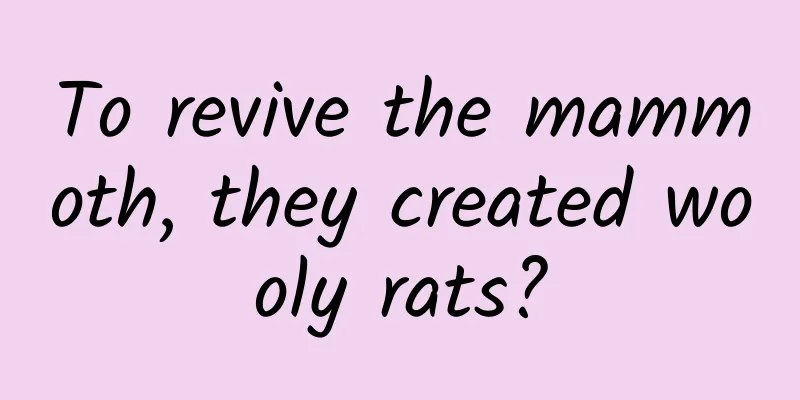To revive the mammoth, they created wooly rats?

|
Last week, a species of " hairy rat " suddenly appeared and attracted worldwide attention. The reason for the attention is not only that the "hairy mouse" is cute, but more importantly, the research team believes that this "hairy mouse" reproduces the hair characteristics of the woolly mammoth, and its birth is an important step in resurrecting the mammoth [1]. "Hairy mice" and normal mice|Colossal Biosciences The company that created the "hairy mouse" is an American biotechnology company called Colossal. One of the company's founders is George Church, a Harvard University professor and geneticist, and the other is serial entrepreneur Ben Lamm. Colossal is committed to resurrecting extinct animals such as mammoths and thylacines . They have said that they hope to create hybrid mammoth cubs by 2028 and reintroduce them into the Arctic permafrost. The woolly mouse was developed to revive the mammoth. In a statement about the woolly mouse, Ben Lam said: "By introducing multiple cold-resistant traits from the mammoth's evolutionary path into existing animal models, we have demonstrated our ability to reconstruct the complex genetic combinations created by nature over millions of years of evolution." The woolly mammoth (Mammuthus primigenius) is a true mammoth that became extinct 4,000 years ago. It was similar in size to the African elephant, but had long, curved incisors, and hair up to half a meter long with a short undercoat, which allowed it to adapt to cold environments. The picture shows a woolly mammoth model at the Royal Museum in the United Kingdom. Wikimedia Commons But can the "woolly mouse" really bring the mammoth back to life? Woolly mice are cute, but they have nothing to do with mammoths Colossal's press releases hint at the similarities between the "woolly mouse" and the mammoth, as if the mammoth could be resurrected immediately if the same operation were applied to the elephant. However, this suggestion is misleading. The cute "woolly mice" we see in the news have only a very tenuous genetic connection to mammoths . The woolly mouse and mammoth are actually very tenuously related | Colossal Biosciences In this study, various combinations of gene editing were performed on experimental mice, involving a total of 10 genes [1]. Of these, nine genes are responsible for regulating hair characteristics, some of which change hair length and some change hair texture. The remaining gene is related to fat metabolism. Of these 10 genes, 7 have nothing to do with mammoths. They are just hair genes found in mouse studies, and no corresponding mutations can be found in mammoths. Editing these genes can certainly change the appearance of mouse hair, but no matter how similar the appearance is to mammoths (which it is not), these are not true "mammoth characteristics" . The appearance of this "hairy mouse" has changed due to the modification of six hair genes - however, none of these six genes have anything to do with mammoths | Rui Chen et al. The remaining three genes are related to the mammoth genome, but it is unclear whether the editing really gave the mice "mammoth characteristics." Although the researchers believe that their manipulation can improve the mice's ability to withstand cold, this has not yet been tested . In short, current research cannot prove that mice have become like mammoths through genetic modification - and even if this is proven, it is still a long way from truly resurrecting mammoths . How far is the technology from resurrecting the mammoth? According to Colossal, "resurrecting the mammoth" can be achieved through genetic editing of Asian elephants . The Asian elephant is the closest living relative of the mammoth. In theory, if you compare the genomes of the two and then modify the differences one by one, you can eventually get an organism with the same genetic material as the mammoth. Asian elephant (Elephas maximus) | Wikimedia Commons But in reality, such a “complete modification” is almost impossible to achieve. Although closely related, mammoths and elephants are still very different. The genomes of these two animals differ by about 1.4 million “letters”, and these differences have changed more than 1,600 protein-coding genes[2]. With so many differences, the workload of modification is too huge and it is difficult to achieve with existing technology. The researchers at Colossal are well aware of this. Therefore, their plan from the beginning was not to truly revive the mammoth, but to edit only some key genes to create a "hybrid" with mammoth characteristics . They call this "hybrid" of elephants and mammoths "mammophants." According to the researchers' conception, the main body of the "mammoth" is still an elephant, but it will have mammoth characteristics such as small ears, long hair, and cold resistance | Yahoo Finance Even if the goal is to create a "mammoth", there are still many unresolved technical problems. Although biotechnologies such as gene editing are relatively mature in mice, these experimental methods cannot be directly transferred to elephants because there are many physiological differences between the two. What specific technical adjustments need to be made are still unknown. Even if elephant embryos are successfully edited, it will be difficult to raise them. Artificial embryos need to be implanted in surrogate mothers for development, but Asian elephants are a rare protected species, and considering animal welfare, it is difficult to use female elephants for large-scale surrogacy . Colossal co-founder George Church once mentioned that he hopes to solve this problem with an “artificial womb”[3]. However, artificial womb technology is still very immature , and a version that can cultivate a fetus from scratch has not yet been developed. With this money, it is better to protect elephants first In addition to technical difficulties, the "resurrection of mammoths" plan has also been questioned by many in terms of its ecological impact. According to Colossal, the ultimate goal of this plan is to create a large number of "mammoths" and then release them into the permafrost environment to let them "fill the ecological niche." They believe that doing so can improve the ecological environment and slow down global warming. Restoration of Ice Age fauna. Is it realistic to release "artificial mammoths" to improve the environment? | Wikimedia Commons This may be a beautiful idea, but no one can guarantee that it will go smoothly. Mammoths have been extinct for more than 4,000 years, and the ecology and climate have changed a lot. The habitat suitable for them may no longer exist. Moreover, the artificially created "wool mammoths" are different from the mammoths of the past. How they will survive and how they will change the environment is even more difficult to say . Colossal has raised hundreds of millions of dollars by relying on the gimmick of "resurrecting mammoths". Critics believe that if the money is used to protect elephants, it will produce much greater benefits than creating "mammoths". It is much easier to gain ecological benefits by protecting elephants than to resurrect mammoths | Wikimedia Commons It is difficult to say whether resurrecting mammoths will improve the environment, but protecting elephants is indeed helpful. For example, studies have found that elephants can play a role in adjusting the structure of vegetation. They eat fast-growing trees with low carbon absorption capacity, leaving room for trees with stronger carbon absorption capacity. Therefore, protecting elephants can increase the ability of tropical rainforests to absorb carbon dioxide, thereby slowing down global warming[4]. If you really want to make the earth a better place, you should start by paying attention to the existing wild animals. References [1]https://www.biorxiv.org/content/10.1101/2025.03.03.641227v1.full.pdf [2]https://www.cell.com/cell-reports/fulltext/S2211-1247(15)00639-7 [3]https://www.nature.com/articles/d41586-024-00670-z [4]https://www.slu.edu/news/2023/january/elephants-atmospheric-carbon-research.php [5]https://theconversation.com/woolly-mice-are-a-first-step-to-resurrecting-mammoths-but-theres-a-very-long-way-to-go-251640 [6]https://www.nature.com/articles/d41586-025-00684-1 Author: Window Knocking Rain Editor: Mai Mai |
<<: Putting this kind of film on your phone will really ruin your eyes... Urgent reminder →
>>: Spring is here, beware of these "invisible" allergens
Recommend
How to make your advertisement popular on Tik Tok?
Everyone knows how popular TikTok is today. If yo...
Android manufacturers are full of lies! You may have received a fake security patch
The fragmentation of the Android system has alway...
In-depth analysis of Apple's bidding advertising (ASM) in Hong Kong, Macau and Taiwan
This sharing is divided into the following 4 part...
Where is the world's longest existing ancient city wall? Not in Beijing, nor in Xi'an...
The basic exhibition hall of Nanjing City Wall Mu...
How many sparks will occur when HTML5 meets Native?
A few days ago, there was a piece of news that at...
LG G Watch R Android smartwatch review
【51CTO translation】Smartwatches such as the LG G ...
Android and Chrome merge, a win-win for developers and Google
[[122279]] For a long time, developers have often...
Bundling wind, solar and thermal power for external transmission? The transformation from transmitting "coal-fired power" to transmitting "green power"
Editor’s Note: Millions of IPs create science pop...
How to formulate a brand strategy? The Four Elements of Brand Strategy
Nowadays, with the continuous development of soci...
iOS 15.5 official version has a big bug that will eat up all your data
Half a month ago, Apple released the official ver...
Three reasons led to a collective change of management at PPTV
Yesterday afternoon, the industry reported that P...
Analysts predict Q2 iPhone sales may disappoint
According to foreign media reports, Jun Zhang, an...
Want to make your money back by eating at a buffet? What kind of sweet dream is that?
Audit expert: Zhou Jiaojiao Associate Professor, ...
June Hot Marketing Calendar Strategy
As June arrives, most of 2022 has passed. By June...









